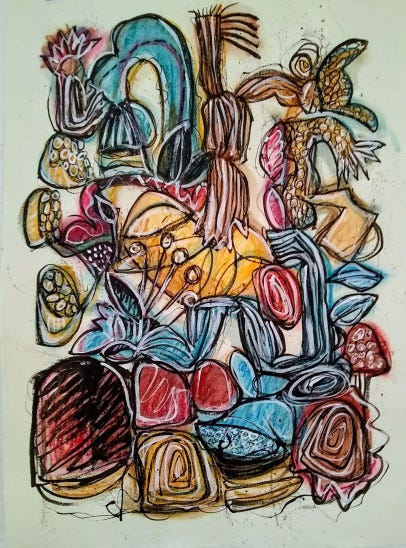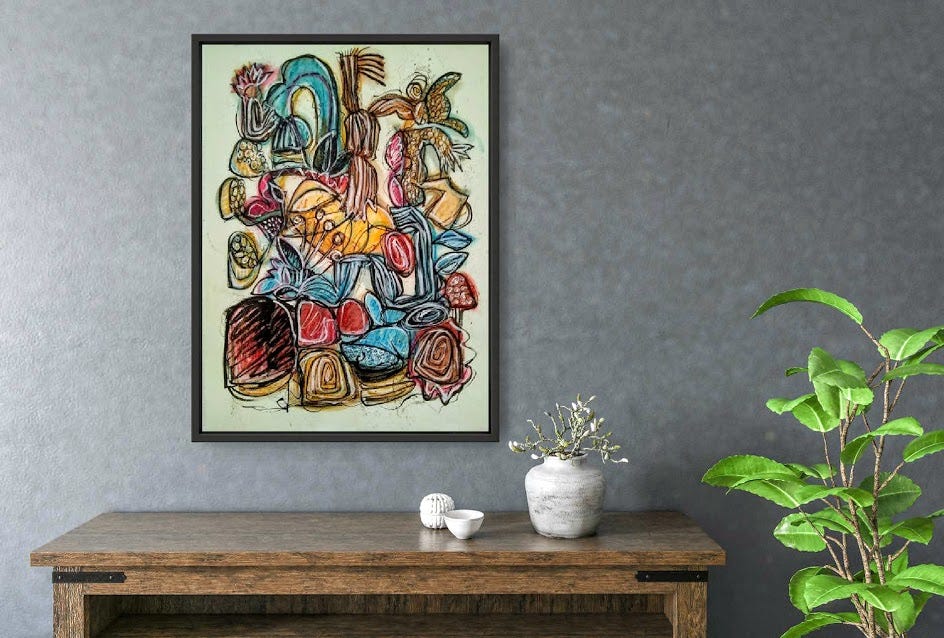4/30/2022 #61
Here and Now, Mastodon, Catalina Cariaga, Art, Algospeak (Doctorow), Strandbeests (Leftwich), Top 10 Sea Creatures, Mateo Pizarro, Seb Lester, Endangered Sounds, Music for Programming x 2, Dreamhop.
HERE AND NOW
Tonight, I’m recovering from volunteering for a large, in-person, nonprofit public event earlier today. Whew. Good turnout, though—considering that this is the first in-person major event we’ve put on since the pandemic started.
Otherwise, I find myself struggling a bit with the current state of pandemic/non-pandemic, if you know what I mean. My KN-95 mask has become my “required” fashion accessory, practically “glued” to my wrist when I go out, so I can use it when needed. But now many people are going without masks at all—in crowded restaurants, in markets, coffee houses, schools, public events, etc. I still don’t feel comfortable with dropping the mask in social situations, and I wonder if I will ever not use a mask in public again when I have a cold, flu, or any other viral illness. I’ve learned so much about how viruses are spread in the last two-and-a-half years, and knowledge makes me want to take precautions. Why are we, in this country, so lax about spreading illness to other people?
Those of you who know I’ve dropped Instagram may be surprised to know I’m still on social media. I’ve been on both Diaspora and Mastodon.org for several years; I often post my art on those sites. These platforms are somewhat similar to Twitter, but, as part of the “Fediverse,” both are non-corporate and decentralized platforms made up of “pods” or “instances,” which can be small (say, 50-100 people) or large, with thousands, and even tens of thousands, of members. How you interact with other members of these pods depends largely on the ethical stances of individuals or “moderators” who run them. So far, I’ve been happy with the mods in Mastodon (but note: it depends on what instance you choose to be on). Recently, I left one of the largest “instances” (mastodon.social: too many global inputs for my taste) and joined a smaller group made up mostly of folks from the San Francisco Bay Area, sfba.social. I also hang out at Mastodon.art, a large and very supportive group of artists. Since Elon Musk bought Twitter, a couple weeks ago, it’s been amusing to watch tens of thousands of Twitter users jumping ship to join Mastodon—even though it’s been a headache (but also exciting) for the mods as they deal with the overload.
Below, you’ll find the second “Six Questions” artist response (I answered the first set of questions, which you’ll find in the previous newsletter). The plan is for this to be an “every other week” thing.
I’ve known Catalina Cariaga since my days as a late-joining member of BAPAW (Bay Area Pilipino American Writers). In the 1980s, as a Filipina American writer in Santa Cruz, I felt very isolated. Meeting the BAPAW writers in San Francisco changed my perspective on writing in many ways, and it was wonderful to have their support and friendship.
SIX QUESTIONS: CATALINA CARIAGA
1. Where did you grow up and how did that (or any other significant experience) influence your art?
I was born in Los Angeles, CA and grew up in a suburb; a town called La Puente in San Gabriel Valley. My parents were immigrants from Illocos Norte, Philippines. My father was a manong, (born 1906); my mother (born 1918) married my father after WWII in 1948. I am the youngest of four children.
Many multicultural moments, in a diverse community―but mostly white, with white expectations. But we were brown. So, I grew up eating California American food and Filipino food at the same table. Mexican and Chicano culture was all around. We also had a lot of extended family―other Ilocano immigrants in the Los Angeles area. Many cousins.
We went to Catholic school, Immaculate Heart of Mary nuns replaced by Carmelite nuns in the 1966 revolt. Vatican II etc. Education was important to my parents. We were your typical nuclear family―rather All American. Baseball. Trips to the southern California beaches. But it is the little details that stand out for a writer . . . that begs the question of expression. We were brown in a white world. We were not meant to own a house; the 50s and 60s still had redlining zones to keep us Filipinos out. But somehow my parents found loopholes. After the Fair Housing Act of 1964, I remember my mom advising other Ilocano friends on how to get FHA and VHA house loans.
My family has a history of bi-polar illness. My father was bi-polar and cycled loud and clear until he died in 2000 at the age of 95. Affective disorder is pronounced in our line, me, siblings, nephews and nieces. The amazing thing is that affective awareness brings out a sensitivity very conducive to creativity and the sciences. Madness is a beautiful thing when it brings our compassion and sensitivity. When I write about madness, I am writing about race. When I write about race, I am writing about madness. Both conditions are marginal in a white dominated culture that seeks to ignore people of color and mental illness as taboo. That has always been a concern when I write. I am really just writing locally, what it is like to move in a world with brown skin. Most white people do not have to even consider this factor of race.
But, as I get older, I really like my brown skin. I am in my skin. I own my brown skin.
2. What’s your creative process like (could include processes, objects around you, timing, spatial needs, impacts from current events, etc.)?
I guess I would describe it as survival mode. I have always kept a journal since I was 20 or so during my college years. I was always typing letters to people. Copying haiku and typing them on 3x5 cards and sending them to people. A friend from college just sent me 20 years of letters I wrote to her and about 300 3x5 cards with typed haiku. No wonder I love the typewriter.
I have a candle of Our Lady of Guadalupe that I light. I write at the computer sometimes. Mostly final drafts. But poem get lost on hard drives. I am trying to find hard copies of stuff I have written over the years.
Lately, in the past 5 years I have been using the typewriter. I collect old typewriters. There is a community of writers out there that love typewriters. It is a different process typing on a typewriter; leaves out self-editing. I guess I would be more prolific if I was in front of a computer all the time. But I guess I like the organic process―I like to be provoked.
3. What puts a damper on your creativity? What do you do—if anything—to remedy that?
Working as a bureaucrat for a university as a financial analyst, motherhood, family, and managing a household. I have always had to find little niches―in our little California bungalow.
Well, the house is paid for, and I am retired with a comfortable pension. But I am finding myself in the throes of “survival mode.” Now I struggle every day to get organized. The remedy: One thing at a time.
4. Does age factor into your creative process, and if yes, how?
Well, yes, I have never really known writing as a priority. Survival and financial security have always loomed. So, I started an MFA program at age 34 at SF State. That is rather late. I also married that same year. That was 1991–1994. But I think a certain maturity both in family life and writing is an asset.
5. What are you working on, currently, and what’s inspiring it?
I am working on my second book of poetry, with a working title, MANIFEST: of Alien Passengers. Diasporic existence. We are all passengers on an alien ship. We now have access to ship manifests for people of color. Used to just be for whites at Ellis Island. But now it is all out there. And of course, the middle passages period lists African slaves—people—as property; and sadly, many searches by African American migration lead to nothing at all.
During the pandemic I started typing small text on small bits of cards which translated into a kind type/text/art poetry. I am continuing to do that as well as make little mail text/type/poetry. A few pieces were published in a couple journals―one is 4-color. Then I took on 3” x 1” piece and blew it up as a 4-foot by 2-foot vinyl poster. I brought it to a reading at City Lights in Kerouac Alley. Barbara Jane Reyes invited me to read. It flew. Kind of freaky. I’d like to do more of that.
But I also have to catch up with what other Asian American and writers of color have been doing. That take time to read. I have the time now.
6. What’s your favorite imperfection (could be yours or someone else’s that you admire)?
I like being “old school.” Typewriter. Old house (built 1922). Play tennis. Play classical guitar, mandolin and ukuleles―old vintage instruments are wonderful. Poetry is old school. Hope more people read poetry. I do not want to be “difficult” but my poetry is not going to be standard English. It will break and create chaos―well, my life has been chaotic and not one of privilege. But I make do. I have the opportunity of health and a certain amount of security to write in a way not afforded to me in the last two dormant decades.
Catalina Cariaga is an American poet. Her book of poetry, Cultural Evidence (Subpress Collective, 1999) was awarded a PEN Open Book Award. She has an MFA from San Francisco State University. She has current work in Tripwire #l7, a Journal of Poetics, and SF Bay’s fourth anthology, Essential Truths: The Bay Area in Color. She is a contributing editor to Poetry Flash, A Poetry and Literary Review for the West. She fixates on the typewriter, working on her next book, Manifest: of Alien Passengers; she lives with her husband and son in their neighborhood of Maxwell Park in Oakland, CA, on unceded Ohlone land.
ART
I’m going through a “dry spell” with my art and writing (except for this newsletter). I don’t have anything new, so here are three oldies, which may look quite different from what I’ve been posting here lately, but these are also related images.
LINKS:
This article on “The Algospeak Dialect,” by Cory Doctorow, is by turns disturbing, hilarious, and pathetic. I can only hope it is spawning a new poetry. “Spicy eggplant” anyone? But seriously, think about the parallels with censorship under fascism. Is AI-driven social media just another form of “big brother” fascism?
Via Jim Leftwich (posted on Mastodon social media): Theo Jansen’s strandbeests are made of pvc tubing, zip-ties, string, and fabric—and they evolve.
Because deep-sea animals are cool: Monterey Bay Aquarium’s Top Ten Deep Sea Animals, introduced by George Matsumoto and Aquarium staff:
“The Best of Seb Lester’s Hand Drawn Calligraphy Videos” (from BOOOOOOOM). Very ASMR:
SOUNDINGS
Thanks to BOOOOOOOM magazine for this link to The Museum of Endangered Sounds and a trip down memory lane . . .
Musicforprogramming.net (for whatever online work you do that needs sound that will help you focus). Pick a number in the right-hand column and click it; go to the middle column and click on “play.”
David Morales presents his list of favorite programming music channels.
Feeling stressed out? Here’s a lofi hip-hop mix for stargazers and dreamers. Extremely low-key music by Dreamhop (Lotus Records):
Fare thee well, until next week. Here’s a little extra, from Inside Llewyn Davis (Dink’s Song) - Marcus Mumford and Oscar Isaac:













Amazing interview with Catalina Cariaga!!!